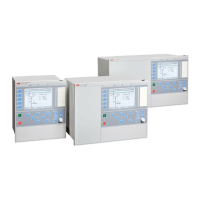Earth-fault transients
In general, earth faults generate transients in currents and voltages. There are several
factors that affect the magnitude and frequency of these transients, such as the fault
moment on the voltage wave, fault location, fault resistance and the parameters of the
feeders and the supplying transformers. In the fault initiation, the voltage of the faulty
phase decreases and the corresponding capacitance is discharged to earth (→
discharge transients). At the same time, the voltages of the healthy phases increase and
the related capacitances are charged (→ charge transient).
If the fault is permanent (non-transient) in nature, only the initial fault transient in
current and voltage can be measured, whereas the intermittent fault creates repetitive
transients.
GUID-CC4ADDEA-EE11-4011-B184-F873473EBA9F V1 EN
Figure 164: Example of earth-fault transients, including discharge and charge
transient components, when a permanent fault occurs in a 20 kV
network in phase C
4.2.3.6 Signals
Table 351: INTRPTEF Input signals
Name
Type Default Description
Io SIGNAL 0 Residual current
Uo SIGNAL 0 Residual voltage
BLOCK BOOLEAN 0=False Block signal for activating the blocking mode
Table 352: INTRPTEF Output signals
Name
Type Description
OPERATE BOOLEAN Operate
START BOOLEAN Start
BLK_EF BOOLEAN Block signal for EF to indicate opposite direction
peaks
Section 4 1MRS758755 A
Protection functions
322 REC615 and RER615
Technical Manual

